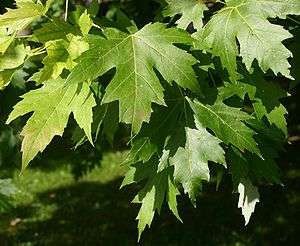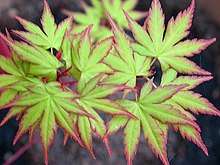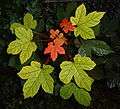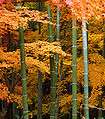| Maples | |
|---|---|
 | |
| Genus: | Acer |
| Family: | Sapindaceae |
| Type: | Trees and shrubs |
Maples are trees or shrubs in the genus Acer. There are approximately 125 species, most of which are native to Asia, but several species also occur in Europe, northern Africa, and North America. Maples are variously classified in a family of their own, the Aceraceae, or (together with the Hippocastanaceae) included in the family Sapindaceae. Modern classifications, including the Angiosperm Phylogeny Group classification, favor inclusion in Sapindaceae.
The word Acer is derived from a Greek word meaning "sharp" (referring to the characteristic points on the leaves) and was first applied to the genus by the French botanist Joseph Pitton de Tournefort in 1700.[1]
Description
Maples are mostly trees growing to 10–40 m (30–130 feet) in height. Others are shrubs less than 10 m tall with a number of small trunks originating at ground level. Most species are deciduous, but a few in southern Asia and the Mediterranean region are evergreen.
Maples are distinguished by opposite leaf arrangement. The leaves in most species are palmately veined and lobed, with 3-9 veins each leading to a lobe, one of which is in the middle. A small number of species differ in having palmate compound, pinnate compound, pinnate veined or unlobed leaves.
Several species, including the Paperbark Maple (Acer griseum), Manchurian Maple (Acer mandshuricum), Nikko Maple (Acer maximowiczianum), and Three-flowered Maple (Acer triflorum), have trifoliate leaves. One species, the Boxelder (Acer negundo), has pinnately compound leaves that may be simply trifoliate or may have five, seven, or rarely nine leaflets. The Hornbeam Maple (Acer carpinifolium), has pinnately-veined simple leaves that resemble those of hornbeams (Carpinus spp.).
The flowers are regular, pentamerous, and borne in racemes, corymbs, or umbels. They have five sepals, five petals about 1 to 6 mm long, 12 stamens about 6–10 mm long in two rings of six, and two pistils or a pistil with two styles. The ovary is superior and has two carpels, whose wings elongate the flowers, making it easy to tell which flowers are female. Maples flower in late winter or early spring, in most species with or just after the leaves appear, but in some before them.
Maple flowers are green, yellow, orange or red. Though individually small, the effect of an entire tree in flower can be striking in several species. Some maples are an early spring source of pollen and nectar for bees.
The distinctive fruit are called samaras or "maple keys". These seeds occur in distinctive pairs each containing one seed enclosed in a "nutlet' attached to a flattened wing of fibrous, papery tissue. They are shaped to spin as they fall and to carry the seeds a considerable distance on the wind. Seed maturation is usually in a few weeks to six months of flowering, with seed dispersal shortly after maturity. Most species require stratification in order to germinate, and some seeds can remain dormant in the soil for several years before germinating.[1]
Most maples freate extensive but shallow root systems, and tend to create very dry shade near the tree, so underplanting can be difficult.
Ecology
Maples tend to grow both as pioneer species and as subcanopies to larger trees. Most cast very dense shade, limiting undergrowth and underplanting.
Culture and Use
Horticulture

Maples are planted as ornamental or shade trees by homeowners, businesses and municipalities. The Norway Maple (Acer platanoides) is especially popular as it is fast-growing and extremely cold-resistant, though is also an invasive species in some regions. Other maples, especially smaller or more unusual species, are popular as specimen trees.[1]
- Cultivars
Numerous maple cultivars that have been selected for particular characteristics are usually propagated by grafting. Japanese Maple (Acer palmatum) alone has over 1,000 cultivars, most of which were selected in Japan.[1] Some delicate cultivars are usually grown in pots and rarely reach heights of more than 50-100 cm.
- Bonsai
Maples are a popular choice for the art of bonsai. Japanese Maple, Trident Maple (Acer buergerianum), Amur Maple (Acer ginnala), Field Maple (Acer campestre) and Montpellier Maple (Acer monspessulanum) are popular choices and respond well to techniques that encourage leaf reduction and ramification, but most species can be used.[1]
- Collections
Maple collections, sometimes called aceretums, occupy space in many gardens and arboreta around the world including the "five great W's" in England: Wakehurst Place Garden, Westonbirt Arboretum, Windsor Great Park, Winkworth Arboretum and Wisley Garden. In the United States, the aceretum at the Harvard University-owned Arnold Arboretum in Boston, Massachusetts is especially notable. In the number of species and cultivars, the Esveld Aceretum in Boskoop, Netherlands is the largest in the world.[1]
Commercial uses
Maples are important as source of syrup and wood. The Sugar Maple (Acer saccharum) is tapped for sap, which is then boiled to produce maple syrup or made into maple sugar or maple candy. Syrup can be made from closely-related species as well, but their output is inferior.
Some of the larger maple species have valuable timber, particularly Sugar Maple in North America, and Sycamore Maple in Europe. Sugar Maple wood, often known as "hard maple", is the wood of choice for bowling pins, bowling alley lanes, drums and butcher's blocks. Maple wood is also used for the production of wooden baseball bats, though less often than ash or hickory.
Some maple wood has a highly decorative wood grain, known as flame maple and quilt maple. This condition occurs randomly in individual trees of several species, and often cannot be detected until the wood has been sawn, though it is sometimes visible in the standing tree as a rippled pattern in the bark. Maple is considered a tonewood, or a wood that carries sound waves well, and is used in numerous instruments such as guitar and the drums.
- Agriculture
As they are a major source of pollen in early spring before many other plants have flowered, maples are important to the survival of honeybees that play a commercially-important role later in the spring and summer.
Pests, Diseases, and other Problems
Maples are affected by a number of fungal diseases. Several are susceptible to Verticillium wilt caused by Verticillium species, which can cause significant local mortality. Sooty bark disease, caused by Cryptostroma species, can kill trees which are under stress due to drought. Death of maples can also be caused more rarely by Phytophthora root rot and Ganoderma root decay. Maple leaves in late summer and autumn are commonly disfigured by "tar spot" caused by Rhystima species and Powdery Mildew caused by Uncinula species, though these diseases do not usually have an adverse effect on the trees' long-term health.[2]
- Drepanaphis acerifoli
- Drepanosiphum platanoides
- Periphyllus aceris
- Norway Maple Aphid: Periphyllus lyropictus
- Boxelder Aphid: Periphyllus negundinis—on Acer negundo
- Black Willow Aphid: Pterocomma simthiae
- Woolly Alder Aphid: Prociphilus tessellatua
- Sweetgum Scale: Diaspidiotus liquidumbaris
- Calico Scale: Eulecanium cerasorum
- Terrapin Scale: Lecanium nigrofasciatum
- Japanese Scale: Leucapsis japonica
- Obscure Scale: Melanaspis obscura
- Gloomy Scale: Melanaspis tenebricosus
- Maple Phenacoccus: Phenacoccus acericola
- Cottony Maple Scale: Pulvinaria innumerabilis
- Cottony Cushion Scale: Icerya purchasi
- Cottony Hydrangea Scale: Pulvinaria hydrangeae
- Cottony Maple Leaf Scale: Pulvinaria acericola
- European Fruit Lecanium Scale: Lecanium corni
- Horse Chestnut Scale: Pulvinaria regalis
- Indian Wax Scale: Ceroplastes ceriferus
- Oystershell Scale: Lepidosaphes ulmi
- Putnam’s Scale: Diaspidiotus ancyllus
- Walnut Scale: Quadraspidiotus juglansregiae
- Leafhopper: Alebra albostriella
- Rose Leafhopper: Edwardsiana rosa
- Japanese Leafhopper: Orientus ishidae
- Maple Leafhopper: Alebra albostriella
- Potato Leafhopper: Empoasca fabae
Psyllids
- Boxelder Psyllid: Cacopsylla negundinis
- Mulberry Whitefly: Tetraleurodes mori
- Comstock Mealybug: Pseudococcus comstocki
- Maple Mealybug: Phenacoccus acericola
- Boxelder Bug: Leptocoris trivittatus
- Fourlined Plant Bug: Poecilocapsus lineatus
- Birch Lacebug: Corythuca pallipes
- Western Boxelder Bug: Leptocoris rubrolineatus
- Pear Thrips: Taeniothrips inconsequens
Flies
- Ocellate Leaf Gall Maker: Cecidomyia ocelaris
- Gouty Veingall Midge: Continaria negundinis
- Maple Gouty Veingall Midge: Dasineura communis
- Asian Longhorn Beetle: Anoplophora glabripennis
- Flatheaded Borer: Chrysobothris femorata
- Metallic Borer: Dicerca divaricata
- Twig Pruner: Elaphidionoides villosus
- Sugar Maple Borer: Glycobius speciosus
- Japanese Beetle: Popillia japonica
- Asiatic Garden Beetle: Maladerma castanea
- Black Twig Borer: Xylosandrus compactus
- Flatheaded Appletree Borer: Chrysobothris femorata
- Pole Borer: Parandra brunnera
- Twig Pruner: Elaphidionoides villosus
- Twobanded Japanese Weevil: Callirhopalus bifasciatus
- Asiatic Oak Weevil: Cyrtepistomus castaneus
- Phyllobius oblongus
- Chionodes negundella - feeds exclusively on Acer negundo, North America
- Brown-tail (Euproctis chrysorrhoea), Europe
- Bucculatrix leaf-miners including:
- Bucculatrix demaryella
- Bucculatrix thoracella
- Buff-tip (Phalera bucephala) - recorded on Norway Maple, Europe
- Coleophora alniella - recorded on Red Maple
- Coxcomb Prominent (Ptilodon capucina) - recorded on Norway Maple, Europe
- The Dun-bar (Cosmia trapezina), Europe
- The Engrailed (Ectropis crepuscularia), Europe
- Feathered Thorn (Colotois pennaria), Europe, Middle East
- Grey Dagger (Acronicta psi) - recorded on Norway Maple, Europe
- The Miller (Acronicta leporina) - recorded on Norway Maple, Europe, North America
- Mottled Pug (Eupithecia exiguata) - recorded on Sycamore Maple, Europe and Asia, Near East
- Mottled Umber (Erannis defoliaria), Europe and Asia, Near East
- November Moth (Epirrita dilutata), Europe, Near East
- Pale November Moth (Epirrita christyi), Europe
- The Satellite (Eupsilia transversa), Europe
- Setaceous Hebrew Character (Xestia c-nigrum), Europe
- Svensson's Copper Underwing (Amphipyra berbera), Europe
- The Sycamore (Acronicta aceris), Europe
- Winter Moth (Operophtera brumata), Europe, West Asia, North America
- American Dagger Moth: Acronicta americana
- Greenstriped Mapleworm: Anisota rubicunda
- Oriental Moth: Cnidocampa flavescens
- Skeletonizer: Epinotia aceriella
- Linden Looper, Basswood Looper: Erannis tiliaria
- Saddled Prominent Caterpillar: Hemerocampa guttivitta
- White-marked Tussock Moth: Hemerocampa leucostigma
- Gypsy Moth: Lymantria dispar
- Forest Tent Caterpillar: Malacosoma disstria
- Leaf Stalk Borer: Nepticula sercoptera
- Brown Tail Moth: Nygmia phaeorrhoea
- Bruce Spanworm: Operophtera bruceata
- Maple Leaf Cutter: Paraclemensia acerifoliella
- Carpenterworm Borer: Prionoxystus robiniae
- Leopard Moth Borer: Zeuzera pyrina
- American Plum Borer: Euzophera semifuneralis
- Bagworm: Thyridopterix ephemeraeformis
- Boxelder Leafroller: Archips negundamus
- Boxelder Leafminer: Caloptilia negundella - on Boxelder
- Carpenterworm: Prionoxystus robiniae
- Cecropia Moth Caterpillar: Hyalophora cecropia
- Eastern Tent Caterpillar: Malacosoma americanum
- Fall Cankerworm: Alsophila pometaria
- Fall Webworm: Hyphantria cunea
- Filament Bearer Caterpillar: Nematocampa limbata
- Fruittree Leafroller: Archips argyrospila
- Hickory Tussock Moth: Halisodota caryae
- Imperial Moth Caterpillar: Eacles imperiales
- Io Moth Caterpillar: Automeris io
- Leopard Moth Borer: Zeuzera pyrina
- Linden Looper: Erannis tiliaria
- Luna Moth Caterpillar: Actias luna
- Maple Leafcutter: Paraclemensia acerifoliella
- Polyphemus Moth Caterpillar: Antheraea polyphemus
- Puss Caterpillar: Megalopyge opercularis
- Redhumped Oakworm: Symmersia canicost
- Yellownecked Caterpillar: Datana ministra
- Filament Bearer Caterpillar: Nematocampa limbata
- Boxelder Twig Borer: Proteoteras willingana
- Hackberry Leaf Slug: Norape ovina
- Hag Moth Caterpillar: Phobetron pithecium
- Spotted Tentiform Leafminer: Phyllonorycter blancardella
- Maple Leafminer: Phyllonorycter aceriella
- Maple Trumpet Skeletonizer: Calastega aceriella
- Maple Twig Borer: Proteoteras aesculana
- Orangehumped Mapleworm: Symmersia leucitys
- Spring Cankerworm: Paleacrita vernata
- Threelined Leafroller: Pandemis limitata
- Pigeon Tremex Borer: Tremex columba
- Gall Mite: Aceria elongatus
- Gall Mite: Aceria modestus
- Gall Mite: Eriophyes acericola
- Gall Mite: Eriophes calacerus
- Gall Mite: Eriophyes negundi
- Maple Spider Mite: Oligonychus aceris
- Gall Mite: Phyllocoptes aceris-crumena
- Maple Bladdergall Mite: Vasates quardipedes
- Maple Spindlegall Mite: Vasates aceriscrumena
 Sycamore Maple leaves
Sycamore Maple leaves Yellow Norway Maple leaves in autumn
Yellow Norway Maple leaves in autumn Japanese Maple trees and bamboo in Japan
Japanese Maple trees and bamboo in Japan Norway Maple leaves
Norway Maple leaves Norway Maple leaves
Norway Maple leaves A bi-colored Bigtooth Maple tree
A bi-colored Bigtooth Maple tree Bench made of highly-figured maple.
Bench made of highly-figured maple.
References
- Britton, Nathaniel Lord; Addison Brown (1913). An Illustrated Flora of the Northern United States and Canada, Volume 1 (second edition ed.). Dover Publications, inc.. pp. 494–498.
- Ann Fowler Rhoads and Timothy A. Block (2000). The Plants of Pennsylvania: An Illustrated Manual. Anna Anisko, illustrator. Morris Arboretum, University of Pennsylvania Press. pp. 118–123.
- Pirone, Pascal P.. Diseases & Pests of Ornamental Plants. pp. 109–117.
- Cranshaw, Whitney (2004). Garden Insects of North America. Princeton University Press. pp. 577–578.